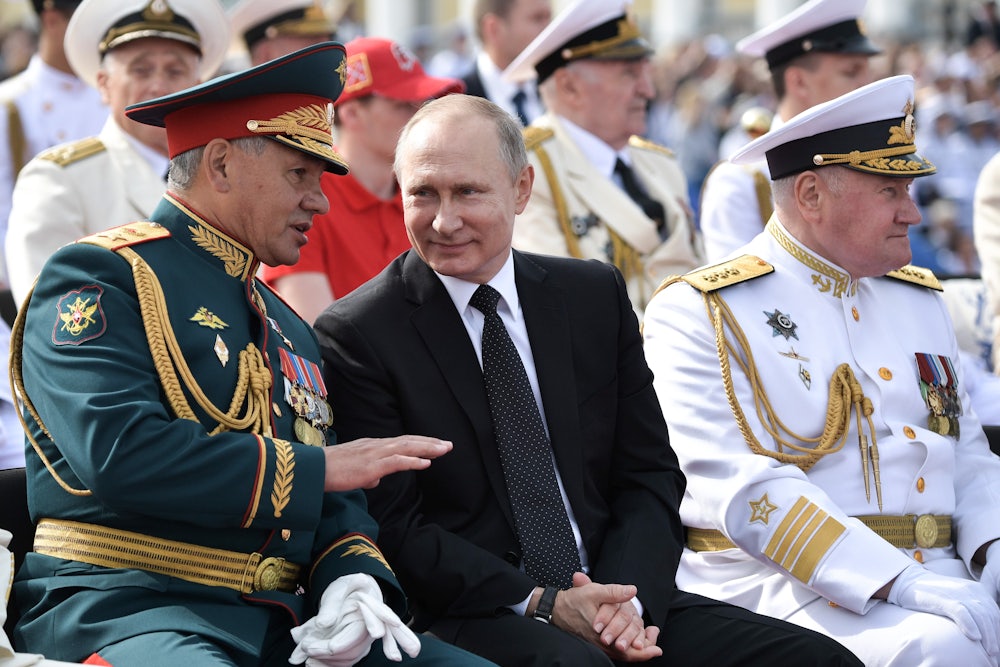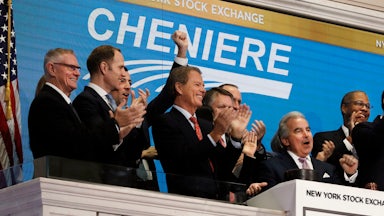As attention was mostly focused on Ukraine yesterday, the Intergovernmental Panel on Climate Change released a nearly 3,700-page report arguing in exhaustive detail that the world’s governments could “miss a brief and rapidly closing window of opportunity to secure a liveable and sustainable future for all.” Already, its 270 co-authors wrote, nearly half of humanity is “highly vulnerable” to climate change, facing unbearable temperatures and violent storms that will likely soon outpace capacities to adapt to them. And one word in particular—“irreversible”—caught the eye of headline writers: Some of the damage from climate change is already irreversible.
For a brief moment last autumn, the world was focused on the climate crisis for the U.N. climate talks in Glasgow, COP26. Now that momentum appears to have faded, replaced by more ostensibly immediate concerns about rising fuel prices and a war that could send them even higher. The climate crisis itself hasn’t let up, of course, as a deadly and climate-fueled “rain bomb” that’s rocked Northeastern Australia can attest. But as the world’s climate scientists warn (again) of the need for “transformative change in socio-ecological systems,” world leaders’ eyes are elsewhere. U.S. energy executives, meanwhile, are taking advantage of the war in Ukraine and the desire to reduce Europe’s energy dependence on Russia by trying to push through a rash of new fossil fuel infrastructure that will stay online for decades to come, continuing to pollute.
What research used to inform the new IPCC report makes clear, however, is that this exact scenario—government attention split between geopolitical crisis and the urgent need for energy transition—may well be a preview of our shared future.
That’s not necessarily because climate change will bring about a dystopian era of conflict, migration, and violence. (The Pentagon has long suggested that climate change requires fortifying the U.S. military for these possibilities.) But overriding concerns about security and national interests—as we’re seeing right now—could well crowd out work to build a more sustainable future. Specifically, authoritarian nationalism—of the sort being acted out by Russian President Vladimir Putin—could undermine the sorts of cooperation and investments that might ward off future violence.
That’s one possibility outlined in the Shared Socioeconomic Pathways employed by IPCC researchers. At the most basic level, SSPs are empirically grounded narratives about possible futures, mapped along an axis of how politically and logistically challenging mitigation and adaptation might be. For more than a decade, climate researchers have been gathering to compile these storylines. The SSPs can be combined with more traditional climate modeling—Representative Concentration Pathways, or RCPs—to form a more holistic picture for what the next decades could look like that expands beyond how many parts per million of carbon dioxide are in the atmosphere. The International Institute for Applied Systems Analysis, in Austria, maintains a database of quantifications for the drivers of different SSPs, such as gross domestic product and population growth projections. Subsequent studies have expanded on the narratives, running them against other data sets. Think of SSPs a bit like a very dry piece of science fiction written over the course of many years at academic conferences, where physical and social scientists versed in complex systems theory leverage massive amounts of data to distill what pathways toward 2100 could entail, and what would help create those potential outcomes.
Perhaps the most fearsome of the five pathways researchers have arrived at is SSP3, described as a “rocky road” where barriers to mitigation and adaptation are both high. “A resurgent nationalism, concerns about competitiveness and security, and regional conflicts push countries to increasingly focus on domestic or, at most, regional issues,” is how researchers summarized SSP3 in a paper published in Global Environmental Change in early 2017, the culmination of more than five years of research. International institutions are weak, in this narrative, with little ability to coordinate to tackle international problems. Governments instead fragment to focus on “national and regional security issues, including barriers to trade, particularly in the energy resource and agricultural markets.” In several regions, authors write, there are “authoritarian forms of government.” It’s possible that “regional conflict over territorial or national issues could produce larger conflict between major countries, giving rise to increasing antagonism between and within regional blocs.”
This isn’t a world that will happen but one that could, Eric Kemp-Benedict, a co-author on the 2017 paper and program director of the Stockholm Environment Institute’s Equitable Transitions Program, told me. Politics has changed dramatically since the SSPs were first unveiled, and he says there are ongoing debates about how to integrate new developments into understandings of the future. “We strive to be analytical rather than political, or more specifically, not partisan,” he said. “We’re trying to think about how political change could occur.” A more qualitative approach allows them to build in possibilities that might be missed by traditional computer modeling and forecasts, which tend to project data we have today out linearly into the future. In complex systems, abrupt changes “can make the current configuration of the system nonviable,” prompting drastic, sudden change that would have been unimaginable beforehand. Among SSP researchers, Kemp-Benedict described “two camps within a common framework: Should you focus on the stasis that characterizes systems for long periods, or those periods of abrupt and large change? There’s no good answer to that because it’s very hard to say when an abrupt change can happen or what the outcome will be because it totally depends on responses at the time. It’s two sensible ways of looking at a complex reality.”
Responses to the pandemic, Kemp-Benedict told me—citing continued poor treatment of essential workers—provided sobering data as to how societies can respond to rising temperatures. “Attitudes exhibited by those responses in times of crisis are also signals of what the possibilities are for the future,” he said. “And those are not particularly promising.”
Reality seems to have changed rapidly over the last several years and weeks, amid both the pandemic and (more recently) as Putin launched a bloody, large-scale invasion of Ukraine. The world looks a bit closer to SSP3 than it might have a few weeks ago. In response to the invasion, Germany has pledged to boost its military spending to 100 billion euros—up from 47 billion last year—and build two new liquefied natural gas terminals. U.S. LNG companies are eager for the opportunity to sign long-term gas-supply contracts in Europe that the continent’s net-zero commitments seemed to make impossible. Hope for comprehensive climate legislation here remains dim.
Climate concerns, that is, are on the back burner compared to just a few months back. As the IPCC report makes clear, though, even when all eyes were on Glasgow, it wasn’t as if the United States and the EU were speeding toward the most optimistic of the SSPs—SSP1, which emphasizes “more inclusive development that respects perceived environmental boundaries” and where “inequality is reduced both across and within countries.” Wealthy governments have consistently failed to live up to their modest $100 billion per year climate-financing pledge. Report authors point to “widening disparities between the estimated costs of adaptation and documented finance allocated to adaptation” and note that the “overwhelming majority” of climate finance has gone to mitigation efforts.
The lion’s share of existing climate finance has taken the form of loans that could put already debt-burdened countries in the global south deeper into the red. The world’s largest historical emitter, the U.S., reportedly pushed over the last two weeks to omit references, in the IPCC report’s Summary for Policymakers, to precisely how little public sector financing has gone toward adaptation efforts, as well as to change the language of finance to “investment,” presuming a greater role for the private sector. During COP26, the U.S. was one of several rich countries blocking the adoption of a specific “loss and damage” financing mechanism to help countries deal with destruction from climate disasters that have already happened; they agreed to a “dialogue” on loss and damage instead. In debates over the report’s summary, the U.S. successfully argued to soften references to loss and damage in some sections.
The report makes clear that some fashionable climate mitigation and adaptation tools could actually make both environmental and political problems worse. It highlights, in particular, the dangers of so-called “maladaptation,” measures that either now or in the future “lead to an increase in the climate vulnerability of a system, sector or group,” and which could exacerbate “existing inequalities.” Voguish mitigation efforts like mass tree plantings (afforestation), which can threaten biodiversity and local populations, were among the possible “maladaptive” mitigation measures evaluated. As the authors wrote, “The most serious emerging conflicts are between land-based approaches to mitigation and the protection of biodiversity.” Adaptation projects that don’t “consider adverse outcomes for different groups,” they add, “can lead to maladaptation, increasing exposure to risks, marginalising people from certain socio-economic or livelihood groups, and exacerbating inequity.” This, in turn, could contribute to the sorts of conflicts described by SSP3. Reckless “green” development and additional warming could fuel low-intensity local and regional violence in places already experiencing various kinds of economic distress, or threats to water access, for instance.
Climate financing from wealthy governments was already scant in a period of historic low interest rates. Though anticipated Federal Reserve and European Central Bank monetary policy tightening may be put on hold due to the situation in Ukraine, adequate adaptation financing doesn’t seem forthcoming. As Western countries turn their attention to domestic cost-of-living crises and defense spending, states and investors could place even more emphasis on dubious public-private partnerships to fill the gaps, and perhaps on the one area of government that’s been immune to talk of fiscal responsibility: the military. Rich governments, warns geographer Patrick Bigger, research director of the Climate and Community Project, could “use deficits as an excuse not to spend on aid, so the only functional response we’ll have to climate change is with the military. You can characterize this as maladaptive in and of itself, if we’re thinking about responding to low-intensity conflict with more military intervention.”
Even though the IPCC report didn’t find that there’s a big chance of climate change leading to big wars (“Compared to other socioeconomic factors the influence of climate on conflict is assessed as relatively weak”), it’s easy to imagine reactionary forces in the U.S., especially, preferring to respond to climate change with military investment. Specifically, that might entail funds to build seawalls around its coastal bases or even potential humanitarian interventions rather than having the U.S. pay its fair share to make equitable, low-carbon development possible worldwide.
Doubling down on military responses to the climate crisis, however—or offering poorer countries loans rather than aid to adapt to climate change—would mean focusing on the symptoms of climate-fueled violence, not its root causes. In many cases, the dire economic conditions contributing to conflict in developing countries can be traced back to colonial legacies and punishing structural adjustment packages imposed by the likes of the International Monetary Fund and the World Bank as a condition of earlier loans.
“We’ve got to ramp up adaptation spending, in particular, by an order of magnitude, and that needs to be distributed in the form of grants” rather than the loans, Bigger said. “That needs to be coupled with comprehensive debt restructuring and debt cancellation to open fiscal space for the countries that are already being harmed by climate change to determine their own adaptation priorities.”
The things that are easiest to fund, that is, aren’t necessarily the best suited for solving problems. It’d be a tragedy if foreign policy hawks were to convince policymakers that Putin’s invasion of Ukraine is cause for doubling down on defense spending as a catch-all solution to the twenty-first century’s many crises—rising temperatures included.










